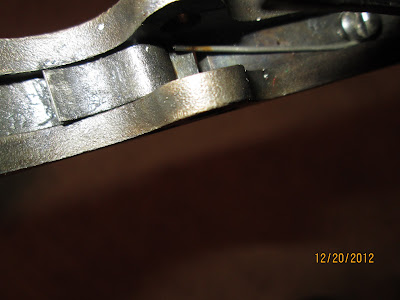When I got my Pedersoli rolling block, I was astounded at how firm the trigger was. Taking it apart, the action proved to be very simple, not allowing for a lot of trickery. Other than bucking up for a complete new double-set trigger setup, there are only 3 things you can do to improve trigger pull. First, you can thin the mainspring. This works, but it increases lock time and could lead to intermittent firing of the primer, so I left it alone. Second, you can change the sear angle. This also works, but there is a risk of making the sear unsafe if the nock tapers away from the sear. The gun can just go off by itself because only friction is holding it cocked. I left this alone as well, except that I do a little polishing to slicken up the feel. Lastly, you can lighten the trigger return spring. This spring pushes the sear up into the notch and the worst drawback if you go too far is that the hammer might not "lock back" and you'll set the hammer back slowly on the firing pin. Once the hammer latches, the trigger return spring is no longer what actively secures the sear, the nock angle is. So, I made a new spring out of "safety wire." This is .032" stainless wire and is significantly softer than the stock spring.
Here you can see the wire wrapped around the mounting screw and resting on the sear. The original spring was a flat strip that filled the whole width of the trough.
The result was a trigger pull of 36 ounces. This sounds light, but in the offhand position it feels terrible.
But this is a blog about Trapdoors, right? Here's a shot of the same concept applied to the Trapdoor lock:
The wire loops around the mounting post and an extra loop slides into the slot that holds the stock spring.
Here you can see that the spring as it pushes on the sear. It may look like the wire would easily fall out, but the wrap around the post holds it well and when installed, the wood of the stock traps the spring.
How does it work? Trigger pull is down to 21 ounces and feels very nice. This is the same setup I used to win the offhand competition a few months ago. By comparison, my Izhmash Ural 5-1 target .22 is set at a pull of 6 ounces and feels like it isn't there at all.




Interesting solution. Did you have to disassemble the lock to install the spring.., or just remove the trigger return spring?
ReplyDeleteThat one big screw is all that has to come off. In general the trapdoor lock isn't tough to disassemble at all if you have the urge to give it a good cleaning. You might need a spring vice (or vice-grips and a piece of leather) to get it back together. Be sure not to let the hammer fall with the lock out. With nothing to stop it, it can break the saddle off.
ReplyDeleteSorry, but I am just now ready to try this solution. To clarify, I only need to take out the screw holding the original return spring, then install the new wire spring as shown in the photos? I am trying to avoid disassembling the entire lock as it was completely cleaned & lubed not long ago. Thanks for your help with this project.
ReplyDeleteThe one screw that holds the small trigger return spring is all you need to remove. I like this modification because if you are making your own spring with wire, the worst that can happen is you have to reassemble with the stock parts. Feel free to experiment.
ReplyDelete